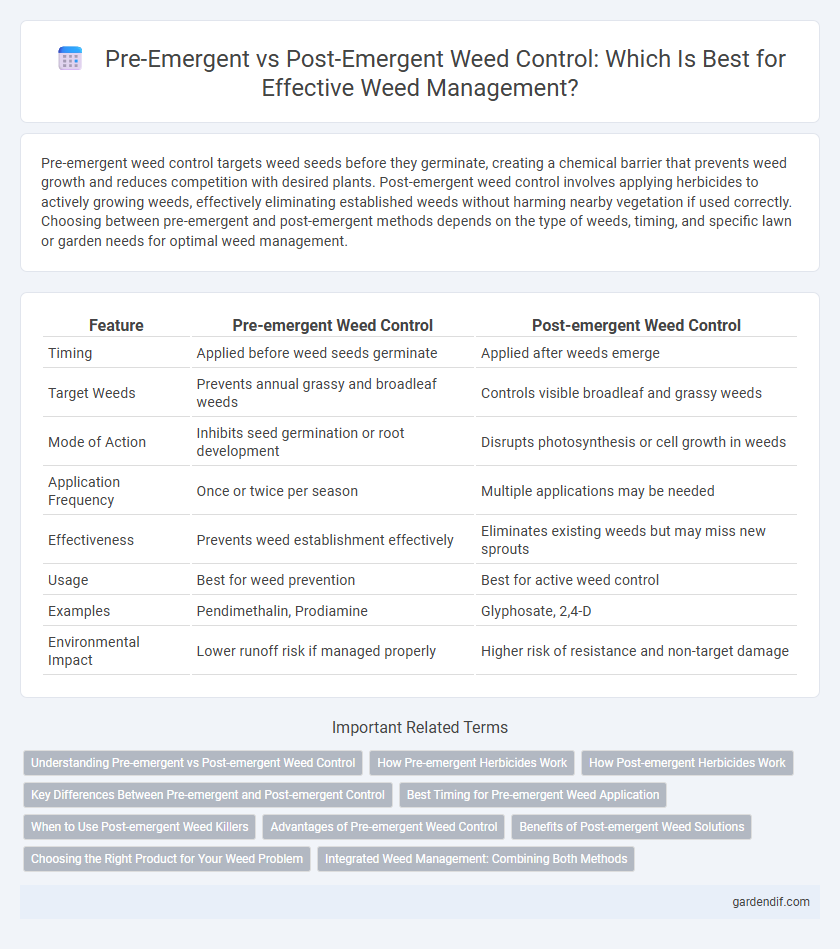
Pre-emergent Weed Control vs Post-emergent Weed Control Illustration
Pre-emergent weed control targets weed seeds before they germinate, creating a chemical barrier that prevents weed growth and reduces competition with desired plants. Post-emergent weed control involves applying herbicides to actively growing weeds, effectively eliminating established weeds without harming nearby vegetation if used correctly. Choosing between pre-emergent and post-emergent methods depends on the type of weeds, timing, and specific lawn or garden needs for optimal weed management.
Table of Comparison
| Feature | Pre-emergent Weed Control | Post-emergent Weed Control |
|---|---|---|
| Timing | Applied before weed seeds germinate | Applied after weeds emerge |
| Target Weeds | Prevents annual grassy and broadleaf weeds | Controls visible broadleaf and grassy weeds |
| Mode of Action | Inhibits seed germination or root development | Disrupts photosynthesis or cell growth in weeds |
| Application Frequency | Once or twice per season | Multiple applications may be needed |
| Effectiveness | Prevents weed establishment effectively | Eliminates existing weeds but may miss new sprouts |
| Usage | Best for weed prevention | Best for active weed control |
| Examples | Pendimethalin, Prodiamine | Glyphosate, 2,4-D |
| Environmental Impact | Lower runoff risk if managed properly | Higher risk of resistance and non-target damage |
Understanding Pre-emergent vs Post-emergent Weed Control
Pre-emergent weed control targets seeds before they germinate, preventing weed growth by creating a chemical barrier in the soil. Post-emergent weed control focuses on eliminating weeds after they have emerged, using herbicides that kill or inhibit existing plants. Understanding the timing and application methods of pre-emergent and post-emergent herbicides is essential for effective weed management and maintaining healthy crops or landscapes.
How Pre-emergent Herbicides Work
Pre-emergent herbicides create a chemical barrier in the soil that prevents weed seeds from germinating and emerging, effectively stopping weeds before they become visible. These herbicides disrupt cell division and root development during seed germination, targeting weed species such as crabgrass and annual bluegrass. Applying pre-emergent herbicides at the correct time, typically early spring or fall, ensures maximum control by inhibiting early growth stages of invasive weeds.
How Post-emergent Herbicides Work
Post-emergent herbicides target weeds after they have sprouted, penetrating leaf tissues to disrupt vital processes such as photosynthesis or hormone regulation. These herbicides are often systemic, traveling through the plant's vascular system to reach roots and inhibit growth. Effective use requires accurate identification of weed species and optimal application timing for maximum absorption and control.
Key Differences Between Pre-emergent and Post-emergent Control
Pre-emergent weed control targets weed seeds during germination to prevent emergence, relying on soil-applied herbicides that form a barrier to inhibit seedling development. Post-emergent weed control eliminates actively growing weeds through foliar-applied herbicides, addressing visible plants after they have emerged. The key difference lies in timing and application method: pre-emergent strategies focus on prevention before weed establishment, while post-emergent controls manage existing weed growth for effective weed management.
Best Timing for Pre-emergent Weed Application
The best timing for pre-emergent weed control is early spring, before weed seeds germinate and soil temperatures reach 55degF to 65degF, which triggers seed sprouting. Applying pre-emergent herbicides during this window prevents weed seedlings from establishing, effectively reducing competition with desirable plants. Precise timing aligned with soil temperature and weed biology maximizes long-term weed management performance.
When to Use Post-emergent Weed Killers
Post-emergent weed killers are most effective when weeds are actively growing and visible above the soil surface, allowing targeted application to disrupt their growth processes. These herbicides work best during the early growth stages of weeds, as mature weeds may develop resistance and require higher application rates for control. Applying post-emergent weed control after pre-emergent treatments ensures a comprehensive strategy for managing both existing and emerging weed populations in lawns and gardens.
Advantages of Pre-emergent Weed Control
Pre-emergent weed control offers the advantage of preventing weed seeds from germinating, which reduces competition for nutrients and water, promoting healthier turf or crops. It minimizes the need for repeated herbicide applications and decreases weed populations before they become established, saving time and costs in the long run. This proactive approach also reduces environmental impact by limiting chemical usage compared to post-emergent treatments applied after weed growth.
Benefits of Post-emergent Weed Solutions
Post-emergent weed control targets weeds after they have emerged, allowing for precise treatment of visible invasive plants, reducing the risk to desirable vegetation. This method provides faster results by directly killing actively growing weeds, improving lawn and crop health more efficiently than pre-emergent solutions. Post-emergent herbicides also offer flexibility in timing and application, addressing weed outbreaks as they occur for better overall management.
Choosing the Right Product for Your Weed Problem
Choosing the right product for weed control depends on whether the weeds are already present or yet to emerge. Pre-emergent herbicides prevent weed seeds from germinating, making them ideal for early-season application to avoid future infestations of common weeds like crabgrass and foxtail. Post-emergent herbicides target actively growing weeds, such as dandelions and clover, requiring precise identification of weed species to ensure effective treatment and minimize damage to desirable plants.
Integrated Weed Management: Combining Both Methods
Integrated Weed Management combines pre-emergent and post-emergent weed control to optimize weed suppression and minimize herbicide resistance. Pre-emergent herbicides prevent weed seed germination, while post-emergent herbicides target actively growing weeds, allowing for comprehensive coverage throughout the weed lifecycle. Utilizing both methods enhances crop health, improves yield, and supports sustainable weed management strategies.
Pre-emergent Weed Control vs Post-emergent Weed Control Infographic

 gardendif.com
gardendif.com